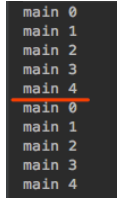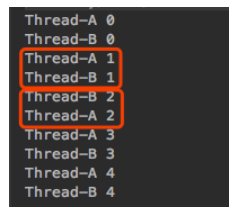一 .任务,进程与线程
多任务: 指用户在同一时间内运行多个应用程序,每个应用程序可以认为是一个任务.常见的操作系统Linux、windows等就是支持多任务的操作系统。 进程: 计算机中的程序关于某数据集合上的一次运行活动,是系统进行资源分配和调度的基本单位,通俗讲就是对操作系统中运行的应用程序及其运行环境的统称。比如window上运行QQ程序,还需占用一定内存 线程: 指应用程序中一个单一的顺序控制流程。是进程内有一个相对独立的、可调度的执行单元,可共享进程的内存资源。 多线程: 在单个应用程序(进程)中同时运行多个线程完成不同的工作 并发: 在同一个进程中,同一个时间段,多个线程争夺共享资源过程
java中的线程
Java程序都运行在Java虚拟机(JVM)中,每用java命令启动一个java应用程序,也即启动一个JVM进程。在这个JVM环境中,所有程序代码的运行都是以线程来运行。举个例子:执行java Helloworld命令,操作系统会在创建一个jvm进程,并分配相应的内存资源,接着运行程序入口main方法,创建一个main线程,用于执行helloworld流程。通常,我们将这个线程称之为主线程,当主线程运行结束后,如果没有其他存活线程,JVM进程也随即退出,释放持有的资源。
线程生命周期:

创建(new)状态: 准备好了一个多线程的对象,即执行了new Thread(); 创建完成后就需要为线程分配内存 就绪(runnable)状态: 调用了start()方法, 等待CPU进行调度 运行(running)状态: 执行run()方法 阻塞(blocked)状态: 暂时停止执行线程,将线程挂起(sleep()、wait()、join()、没有获取到锁都会使线程阻塞), 可能将资源交给其它线程使用 死亡(terminated)状态: 线程销毁(正常执行完毕、发生异常或者被打断interrupt()都会导致线程终止)

二 . 创建线程的方式
-
继承 Thread
-
实现 Runable
-
实现 Callable
2.1 继承Thread 重写run方法
public class Test001 { public static void main(String[] args) { new MyThread().run(); } } class MyThread extends Thread{ @Override public void run() { System.out.println(Thread.currentThread().getName()+"----"+Thread.currentThread().getId()); } }
thread类源码:
package java.lang; public class Thread implements Runnable { // 构造方法 public Thread(Runnable target); public Thread(Runnable target, String name); public synchronized void start(); }
Runnable 接口:
package java.lang; @FunctionalInterface public interface Runnable { pubic abstract void run(); }
2.2 实现java.lang.Runnable接口,重写run()方法,然后使用Thread类来包装:
public class Test002 { public static void main(String[] args) { MyThread002 thread002 = new MyThread002(); new Thread(thread002).run(); } } class MyThread002 implements Runnable{ public void run() { System.out.println(Thread.currentThread().getName()); } }
public class Main { public static void main(String[] args) { // 匿名内部类 new Thread(new Runnable() { @Override public void run() { System.out.println(Thread.currentThread().getName() + "\t" + Thread.currentThread().getId()); } }).start(); // 尾部代码块, 是对匿名内部类形式的语法糖 new Thread() { @Override public void run() { System.out.println(Thread.currentThread().getName() + "\t" + Thread.currentThread().getId()); } }.start(); // Runnable是函数式接口,所以可以使用Lamda表达式形式 Runnable runnable = () -> {System.out.println(Thread.currentThread().getName() + "\t" + Thread.currentThread().getId());}; new Thread(runnable).start(); } }
2.3 实现Callable接口,重写call()方法,然后包装成java.util.concurrent.FutureTask, 再然后包装成Thread
Callable:有返回值的线程,能取消线程,可以判断线程是否执行完毕
public class Main { public static void main(String[] args) throws Exception { // 将Callable包装成FutureTask,FutureTask也是一种Runnable MyCallable callable = new MyCallable(); FutureTask<Integer> futureTask = new FutureTask<>(callable); new Thread(futureTask).start(); // get方法会阻塞调用的线程 Integer sum = futureTask.get(); System.out.println(Thread.currentThread().getName() + Thread.currentThread().getId() + "=" + sum); } } class MyCallable implements Callable<Integer> { @Override public Integer call() throws Exception { System.out.println(Thread.currentThread().getName() + "\t" + Thread.currentThread().getId() + "\t" + new Date() + " \tstarting..."); int sum = 0; for (int i = 0; i <= 100000; i++) { sum += i; } Thread.sleep(5000); System.out.println(Thread.currentThread().getName() + "\t" + Thread.currentThread().getId() + "\t" + new Date() + " \tover..."); return sum; } }
public static void main(String[] args) throws Exception { new Thread(()-> { for (int i = 0; i < 5; i++) { System.out.println(Thread.currentThread().getName() + " " + i); try { Thread.sleep(200); } catch (InterruptedException e) { } } }, "Thread-A").start(); new Thread(()-> { for (int j = 0; j < 5; j++) { System.out.println(Thread.currentThread().getName() + " " + j); try { Thread.sleep(200); } catch (InterruptedException e) { } } }, "Thread-B").start(); }
public static void main(String[] args) throws Exception { new Thread(()-> { for (int i = 0; i < 5; i++) { System.out.println(Thread.currentThread().getName() + " " + i); try { Thread.sleep(200); } catch (InterruptedException e) { } } }, "Thread-A").run(); new Thread(()-> { for (int j = 0; j < 5; j++) { System.out.println(Thread.currentThread().getName() + " " + j); try { Thread.sleep(200); } catch (InterruptedException e) { } } }, "Thread-B").run(); }
执行的都是主线程:

run(): 调用线程的run方法,就是普通的方法调用,虽然将代码封装到两个线程体中,可以看到线程中打印的线程名字都是main主线程,run()方法用于封装线程的代码,具体要启动一个线程来运行线程体中的代码(run()方法)还是通过start()方法来实现,调用run()方法就是一种顺序编程不是并发编程。
public static native void sleep(long millis) throws InterruptedException; public void interrupt();
sleep(long millis): 睡眠指定时间,程序暂停运行,睡眠期间会让出CPU的执行权,去执行其它线程,同时CPU也会监视睡眠的时间,一旦睡眠时间到就会立刻执行(因为睡眠过程中仍然保留着锁,有锁只要睡眠时间到就能立刻执行)。
sleep(): 睡眠指定时间,即让程序暂停指定时间运行,时间到了会继续执行代码,如果时间未到就要醒需要使用interrupt()来随时唤醒。interrupt(): 唤醒正在睡眠的程序,调用interrupt()方法,会使得sleep()方法抛出InterruptedException异常,当sleep()方法抛出异常就中断了sleep的方法,从而让程序继续运行下去.
3.3 wait() 与 notify()
wait、notify和notifyAll方法是Object类的final native方法。所以这些方法不能被子类重写,Object类是所有类的超类,因此在程序中可以通过this或者super来调用this.wait(), super.wait()
wait(): 导致线程进入等待阻塞状态,会一直等待直到它被其他线程通过notify()或者notifyAll唤醒。该方法只能在同步方法中调用。如果当前线程不是锁的持有者,该方法抛出一个IllegalMonitorStateException异常。
wait(long timeout): 时间到了自动执行,类似于sleep(long millis) notify(): 该方法只能在同步方法或同步块内部调用, 随机选择一个(注意:只会通知一个)在该对象上调用wait方法的线程,解除其阻塞状态 notifyAll(): 唤醒所有的wait对象
public class WaitNotifyTest { public static void main(String[] args) throws Exception { WaitNotifyTest waitNotifyTest = new WaitNotifyTest(); new Thread(() -> { try { waitNotifyTest.printFile(); } catch (InterruptedException e) { e.printStackTrace(); } }).start(); new Thread(() -> { try { waitNotifyTest.printFile(); } catch (InterruptedException e) { e.printStackTrace(); } }).start(); new Thread(() -> { try { System.out.println(new Date() + "\t" + Thread.currentThread().getName() + "\t睡觉1秒中,目的是让上面的线程先执行,即先执行wait()"); Thread.sleep(1000); } catch (InterruptedException e) { e.printStackTrace(); } waitNotifyTest.notifyPrint(); }).start(); } private synchronized void printFile() throws InterruptedException { System.out.println(new Date() + "\t" + Thread.currentThread().getName() + "\t等待打印文件..."); this.wait(); System.out.println(new Date() + "\t" + Thread.currentThread().getName() + "\t打印结束。。。"); } private synchronized void notifyPrint() { this.notify(); System.out.println(new Date() + "\t" + Thread.currentThread().getName() + "\t通知完成..."); } }

wait():让程序暂停执行,相当于让当前,线程进入当前实例的等待队列,这个队列属于该实例对象,所以调用notify也必须使用该对象来调用,不能使用别的对象来调用。调用wait和notify必须使用同一个对象来调用。
3.4 sleep() 与 wait()
Thread.sleep(long millis): 睡眠时不会释放锁
public static void main(String[] args) throws InterruptedException { Object lock = new Object(); new Thread(() -> { synchronized (lock) { for (int i = 0; i < 5; i++) { System.out.println(new Date() + "\t" + Thread.currentThread().getName() + "\t" + i); try { Thread.sleep(1000); } catch (InterruptedException e) { } } } }).start(); Thread.sleep(1000); new Thread(() -> { synchronized (lock) { for (int i = 0; i < 5; i++) { System.out.println(new Date() + "\t" + Thread.currentThread().getName() + "\t" + i); } } }).start(); }
3.5 守护线程setDaemon(boolean on)
线程分两种:
-
用户线程:如果主线程main停止掉,不会影响用户线程,用户线程可以继续运行。
-
守护线程:如果主线程死亡,守护线程如果没有执行完毕也要跟着一块死(就像皇上死了,带刀侍卫也要一块死),GC垃圾回收线程就是守护线程
public static void main(String[] args) { Thread thread = new Thread() { @Override public void run() { IntStream.range(0, 5).forEach(i -> { try { Thread.sleep(1000); } catch (InterruptedException e) { e.printStackTrace(); } System.out.println(Thread.currentThread().getName() + "\ti=" + i); }); } }; thread.start(); for (int i = 0; i < 2; i++) { System.out.println(Thread.currentThread().getName() + "\ti=" + i); } System.out.println("主线程执行结束,子线程仍然继续执行,主线程和用户线程的生命周期各自独立。"); }

public static void main(String[] args) { Thread thread = new Thread() { @Override public void run() { IntStream.range(0, 5).forEach(i -> { try { Thread.sleep(1000); } catch (InterruptedException e) { e.printStackTrace(); } System.out.println(Thread.currentThread().getName() + "\ti=" + i); }); } }; thread.setDaemon(true); thread.start(); for (int i = 0; i < 2; i++) { System.out.println(Thread.currentThread().getName() + "\ti=" + i); } System.out.println("主线程死亡,子线程也要陪着一块死!"); }




